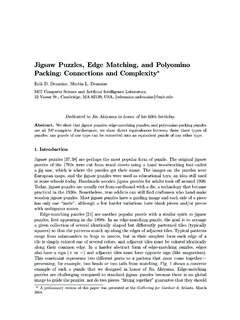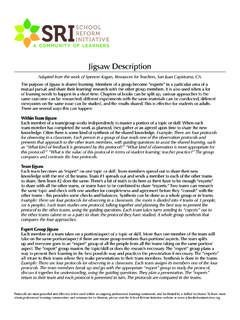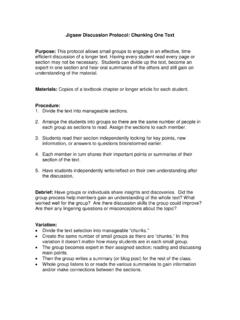Transcription of CLASSROOM COMPETITION AND CULTURAL DIVERSITY - …
1 BASIC jigsaw 1. CLASSROOM COMPETITION AND CULTURAL DIVERSITY . American education has been in a state of crisis for almost as long as we can remember. This has been particularly true during the past four decades, when dramatic changes in our society as awhole have are reflected in our public schools, turning them into veritable pressure cookers. Added demands are being placed on teachers who struggle to open minds and guide the development of skills in increasingly crowded and impoverished surroundings. Declining test scores have had many explanations: Teachers view many children as unprepared for learning when they first arrive at school. Parents point the finger at the schools as incompetent to educate their children.
2 Politicians put the blame on "frills" and periodically demand that schools go back to basics. Everyone blames society for lowered standards of behavior. But finger pointing and blaming are not the best way to solve problems. What is clear is that our society is moving toward increased DIVERSITY and children come to the CLASSROOM with as almost as many di erent experiences and expectations as there are children. They have di erent personalities, di erent skills, di erent abilities, di erent CULTURAL backgrounds, di erent levels of self- esteem and di erent emotional needs. All of these must be accommodated--at least to some extent--in order for a child to learn e ciently. Most teachers are well aware that CLASSROOM learning is not an "either-or" thing: Rather, a child's emotional well-being and sense of self are certain to have a powerful impact on his or her acquisition of traditional knowledge and basic skills in the CLASSROOM .
3 Indeed, research has shown that, under conducive conditions, emotional and intellectual growth go hand in hand; sensible techniques aimed at increasing a child's emotional well-being also have a positive impact on learning the basics. jigsaw BASICS !1. What are "conducive" conditions--and how can they be implemented? On the following pages we will describe one CLASSROOM technique that, over the past 25 years has succeeded in establishing a CLASSROOM atmosphere that produces exciting changes in the performance, the morale, and the well- being of children. The technique is a very simple one; hundreds of teachers and thousands of students have mastered it quickly and enjoy using it. In a nutshell, the technique produces a CLASSROOM structure that enables children to cooperate with one another to attain their educational objectives and, simultaneously, to develop important interpersonal skills and a sharp increase in mutual appreciation in an atmosphere that is exciting and challenging rather than threatening or anxiety- producing.
4 As class sizes have continued to grow, teachers who have used this strategy have learned (to their delight) that they can rely, increasingly, on their students' enhanced interpersonal skills to help with CLASSROOM management. In the following chapters we will describe this technique and present some evidence for its e cacy. We will then present detailed ways of establishing it in the CLASSROOM . But first, let's take a brief look at the broader societal issues that form the background out of which this educational strategy emerged. COMPETITION IN SOCIETY. Americans have made a religion of winning. From the fans in football stadiums chanting "We're number one" and the little leaguer who bursts into tears when his team loses to business leaders and economic pundits who worry about trade with Japan and the value of the dollar, our society asserts its allegiance to victory and its contempt for losers.
5 Our economic system is based on COMPETITION and much of American life is framed in competitive terms; newspapers regularly publish rankings of everything from sports teams to movie box o ce receipts; magazines publish articles about the 50. most beautiful people, the 10 best restaurants, or the 25 Americans with the highest incomes. One of the worst things you can sat about your neighbor is that he or she is "a loser"! What are the consequences of this attitude? How do people behave when COMPETITION is a way of life? We experience a great deal of anxiety when our performance is being observed or measured;. we come to view one another as competitors and potential enemies; we are forever looking over our shoulder lest someone overtake us.
6 We may experience pangs of envy when an acquaintance lands a good job or becomes a successful doctor, lawyer, or barber and we come to look down on those who don't succeed. Once on this treadmill there is no respite, no resting place. For many people in our jigsaw BASICS !2. society, even reaching great heights of accomplishment does not lead to peace but to still greater anxiety lest they fall from grace. And this anxiety is not unwarranted. Coaches who don't produce winning teams, salespeople who don't make quota, even scientists who don't publish first, find themselves looking for employment. In a society obsessed with winning, each of us is only as good as our most recent performance. Some may become so anxious about losing that they decide to stop competing altogether; they become listless in school or at work, simply trying to get through the day-- or they might drop out altogether.
7 This is not to suggest that COMPETITION is evil, or even that it is always dysfunctional. Under many circumstances COMPETITION can be fun. It can add zest to an otherwise dull assignment. Moreover there are situations where adding a dash of COMPETITION can enhance performance. But, over and over again, we have found that unbridled COMPETITION --the relentless concern with being number one, with beating the other person can be, at best, limiting and, at worst, destructive and debilitating. COMPETITION IN THE CLASSROOM . Intense competitiveness is not inborn, but, in our society, it often seems to be because it is learned so early and is so pervasive. Undoubtedly, for most of us, it is communicated and fostered by the family and the media.
8 But one of the major places where it has been taught, indirectly but systematically, is the CLASSROOM . Before looking at the competitive aspect of CLASSROOM education, it might be useful for our adult readers to try to remember what it was like to be a youngster in elementary school. Some may recall their elementary school days with feelings of pleasant nostalgia, others with dread and anxiety. Either way, it is almost invariably the bond (or lack thereof ) with the teacher that stands at the center of the memory. Recent innovations such as team teaching, computers in the CLASSROOM , and the extensive use of outside resources have added new dimensions to the atmosphere of many modern classrooms. But whether primarily traditional or primarily innovative, virtually all CLASSROOM share two common aspects: the major "process" that occurs is highly competitive, and the ultimate goal of the COMPETITION among students is to win the approval and respect of the teachers--to show these important people that we are worthy of their or his respect--and perhaps even their love.
9 What do we mean by "process"? Whenever two or more people interact, two events occur simultaneously. One of these is the content and the other is the process. Content refers to the jigsaw BASICS !3. substance or subject matter of the encounter; process refers to the dynamics of the encounter, how it occurs. For example, in a CLASSROOM the content could be arithmetic, geography, social studies, or music; the process is the manner in which these lessons are taught. It is through the process that people learn a great deal about the world they live in. Indeed, it might even be argued that in the elementary school CLASSROOM the process is a broader and more important source of learning than the content itself.
10 The teaching process as it relates to COMPETITION is well known. Here is a common scene: the teacher stands in front of the CLASSROOM and asks a question which the children are expected to answer. A few children strain in their seats and wave their hands in the teacher's face, seemingly eager to be called upon. Several other students sit quietly with their eyes averted as if trying to make themselves invisible. When the teacher calls on one of the students you can see looks of disappointment, dismay, and unhappiness on the faces of the eager students. If the student who is called upon comes up with the right answer, the teacher smiles, nods her head, and goes on to the next question. That smile and nod is a great reward.









